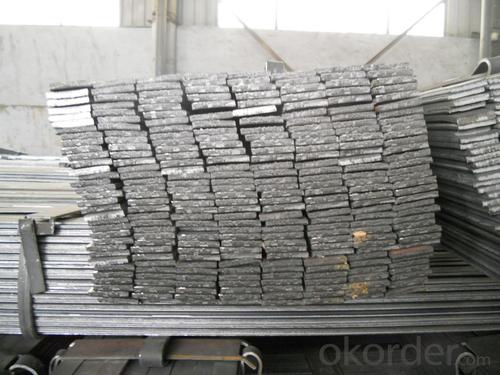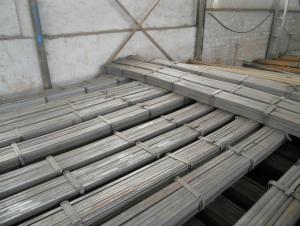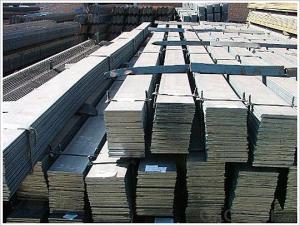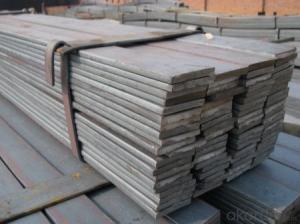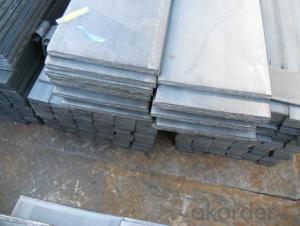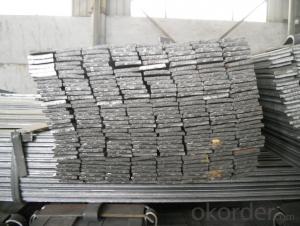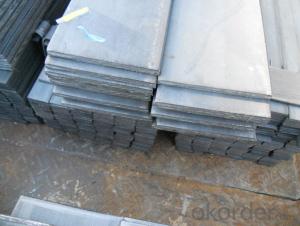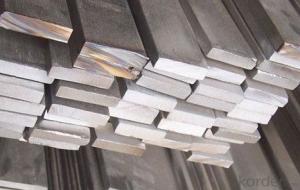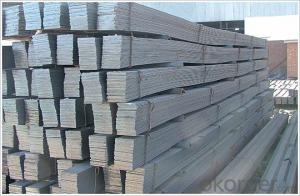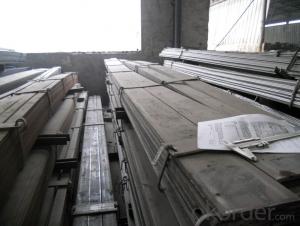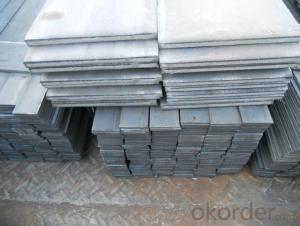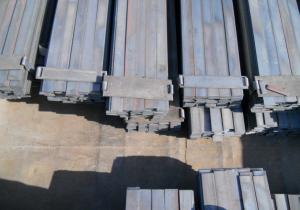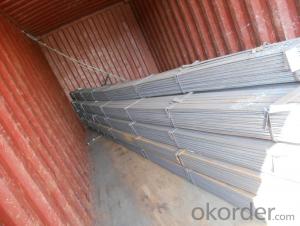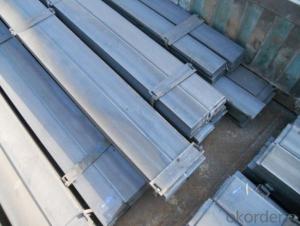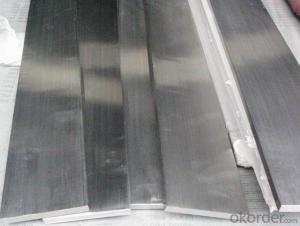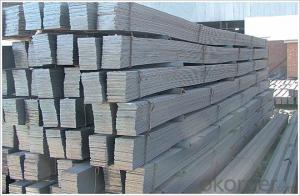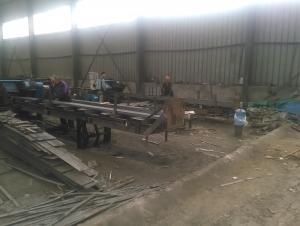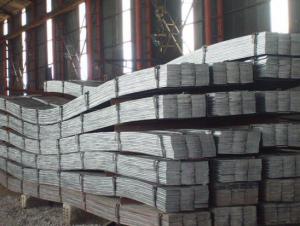Q235 Hot Rolled Steel Flat Bar
- Loading Port:
- Tianjin
- Payment Terms:
- TT OR LC
- Min Order Qty:
- -
- Supply Capability:
- 100000 m.t./month
OKorder Service Pledge
OKorder Financial Service
You Might Also Like
Specification of High Quality Flat Bar
Commodity: High Quality Flat Bar
Standard: GB;ASTM;JIS
Material: Q195-Q235;SS400;
Brand name: FLATSPACE
Origin place: China
Thickness: 3mm-30mm
Width:20mm-200mm
Length: Max 12m
Certification: SGS/BV
Chemical composition of Q235
Alloy No | Grade | Element(%) | ||||
C
| Mn
| S
| P
| Si
| ||
Q235
|
B
|
0.12—0.20 |
0.3—0.7 |
≤0.045 |
≤0.045
|
≤0.3
|
Physical properties of Q235
Alloy No | Grade | Yielding strength point(Mpa) | Tensile strength (Mpa) | Elongation after fracture(%) | ||||||
Thickness (mm) | Thickness (mm) | |||||||||
≤16 | >16--40 | >40--60 | >60--100 |
| ≤16 | >16--40 | >40--60 | >60--100 | ||
≥ | ≥ | |||||||||
Q235 |
B |
235 |
225 |
215 |
205 |
375--500 |
26 |
25 |
24 |
23 |
Usage/Applications of High Quality Flat Bar
Widely used for construction,
Machinery manufacturing,
Iron tower steel structure,
Shipbuilding;
Steel grating,
Staircase,
Bridge,
Viaduct,
Railway spare parts,
Boilers making etc.
Production Flow of High Quality Flat Bar
The steel flat bar is made through three processes:
1.Feeding the material: Feeding the row material (the steel plate) to Slitting Line.
2.Slitting:The steel plate would be slitted into expected width by lengthways cutter.
3. Leveled and cutting: The plat bar would be ground into level by the grinder and then cut into required length.
Packaging & Delivery of High Quality Flat Bar
Packaging Details: The Steel Flat Bars are packed in bundles and loaded in 20 feet/40 feet container, or shipped by bulk cargo ,also we can do as customer's requirements.
Delivery Details:30~45 days upon the receipt of buyer payment by T.T. or L/C.
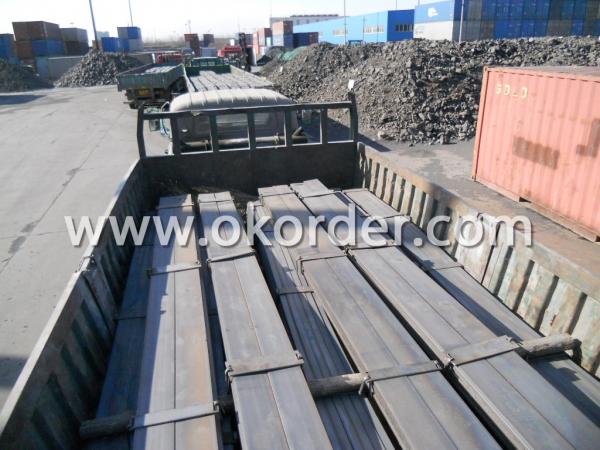
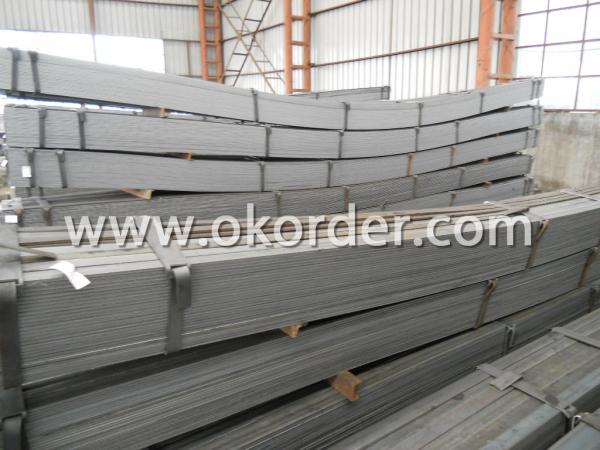
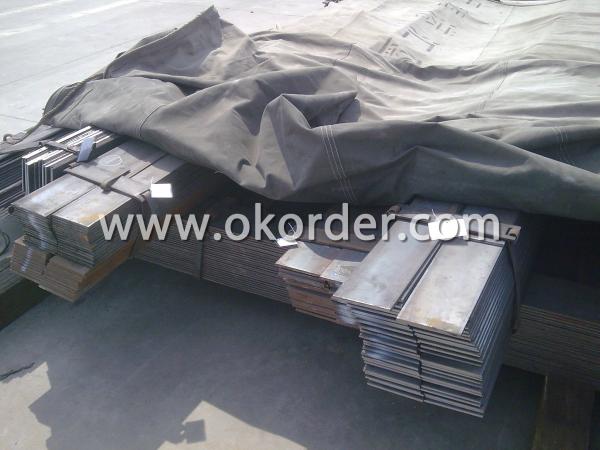
- Q: Cold rolled flat steel standard. What is cold rolled flat steel?
- Section steel is one of the four major steel products (plate, tube, mould, wire). According to the section shape, the section steel is divided into simple section steel and complex section steel (deformed steel). The former refers to the steel, round steel, flat steel, angle steel, six angle steel; the latter refers to the I-beam, channel steel, steel, steel, steel frame bending etc..
- Q: What are the different methods of surface coloring for steel flat bars?
- There are several different methods of surface coloring for steel flat bars, each with its own unique advantages and applications. Some of the most commonly used methods include: 1. Hot-dip galvanizing: This process involves immersing the steel flat bar into a bath of molten zinc, which creates a protective layer on the surface. Galvanizing provides excellent corrosion resistance and is often used in outdoor or high-moisture environments. 2. Powder coating: Powder coating involves applying a dry powder paint to the surface of the steel flat bar, which is then cured using heat. This method offers a wide range of color options, excellent durability, and resistance to chipping, scratching, and fading. 3. Electroplating: Electroplating is a process where a thin layer of metal, such as chrome or nickel, is deposited onto the steel flat bar's surface using an electric current. This method can enhance the appearance of the steel while also providing corrosion resistance. 4. Paint coating: The traditional method of applying paint directly to the surface of the steel flat bar is still widely used. It allows for a wide variety of colors and finishes, but the durability and corrosion resistance may not be as high as other methods. 5. Chemical coloring: This method involves using chemicals to create a controlled oxidation process on the steel flat bar's surface, resulting in various colors and shades. Chemical coloring can provide an attractive appearance while also increasing corrosion resistance. 6. Anodizing: Anodizing is primarily used for aluminum, but it can also be applied to steel flat bars. It involves creating an oxide layer on the surface through an electrochemical process, resulting in enhanced corrosion resistance and the ability to add color through dyes. Each of these methods has its own set of advantages and considerations, such as cost, environmental impact, durability, and aesthetic appeal. The choice of surface coloring method will depend on the specific requirements of the application, including the desired appearance, level of corrosion resistance, and budget constraints.
- Q: Are steel flat bars suitable for architectural or interior design purposes?
- Yes, steel flat bars are suitable for architectural and interior design purposes. They are known for their strength, durability, and versatility, making them an excellent choice for various applications in design projects. Steel flat bars can be used to create modern and sleek designs, such as handrails, furniture, decorative accents, and structural elements. Their sleek and minimalist appearance can add a contemporary touch to architectural and interior spaces. Additionally, steel flat bars can be easily customized, bent, or welded to achieve desired shapes and designs, making them a popular choice among architects and designers.
- Q: What is the appearance of hot galvanizing and cold galvanized flat steel?
- Cold galvanizing is zinc plating, the amount of zinc plating is very little, only 10 - 50g/m2, and its corrosion resistance is much different from that of galvanized pipe. Regular galvanized pipe manufacturer, in order to ensure quality, most do not use electro galvanized (Leng Du). Only small enterprises with small equipment and old equipment use zinc plating, of course, their prices are relatively cheaper. At present, the Ministry of construction has officially completed the following, the elimination of backward cold galvanized pipe, the future is not allowed to use cold galvanized pipe for water, gas pipes.
- Q: How do steel flat bars compare to ceramic flat bars?
- Different properties and characteristics distinguish steel flat bars from ceramic flat bars, making them appropriate for various applications. Known for their strength and durability, steel flat bars consist of a blend of iron and carbon, resulting in a high tensile strength. This quality renders them perfect for heavy-duty applications like construction, manufacturing, and the automotive industry. Furthermore, steel flat bars exhibit resistance to impact, minimizing the likelihood of breakage or cracking under pressure. Additionally, their malleability allows for easy welding and manipulation, enhancing their versatility. Conversely, ceramic flat bars are renowned for their resistance to heat and low friction properties. Crafted from non-metallic materials, such as clay or porcelain, these bars undergo high-temperature firing, rendering them ideal for applications requiring heat resistance, such as furnace linings or kiln furniture. Moreover, their low friction characteristics deem them suitable for applications where friction reduction is crucial, such as bearings or cutting tools. In terms of aesthetics, steel flat bars emanate a metallic and industrial appearance, while ceramic flat bars exude refinement and elegance. This visual discrepancy may influence the selection between the two types of flat bars, depending on the desired visual impact within the application. To summarize, steel flat bars are favored for their strength, durability, and versatility, making them appropriate for heavy-duty applications. Conversely, ceramic flat bars are valued for their heat resistance and low friction properties, making them ideal for applications necessitating these attributes. Ultimately, the decision between steel and ceramic flat bars hinges on the specific requirements and demands of the application at hand.
- Q: Can steel flat bars be used in architectural designs?
- Yes, steel flat bars can definitely be used in architectural designs. Steel flat bars are versatile and can be used in a variety of ways to enhance the aesthetics and functionality of architectural projects. They can be used for structural elements such as beams, columns, and braces, as well as for decorative purposes like handrails, window frames, and furniture. Steel flat bars offer strength, durability, and a sleek, modern look that can complement a wide range of architectural styles. With proper design and fabrication, steel flat bars can be integrated seamlessly into architectural designs, adding both visual interest and structural support.
- Q: Can steel flat bars be used for making telecommunications industry equipment?
- Yes, steel flat bars can be used for making telecommunications industry equipment. Steel is a versatile and durable material that can provide the necessary strength and stability required for telecommunications equipment. Additionally, steel can also be easily shaped and fabricated to meet specific design requirements, making it suitable for various applications in the telecommunications industry.
- Q: How do steel flat bars perform in high-vibration environments?
- Steel flat bars are known for their exceptional strength and durability, making them suitable for a wide range of applications. However, when it comes to high-vibration environments, their performance can be affected. In high-vibration environments, steel flat bars are prone to fatigue failure due to the repeated stress cycles caused by the vibrations. This can lead to cracking or even complete failure of the bars over time. To mitigate these issues, there are several measures that can be taken. The first is to select a steel alloy that has high resistance to fatigue and can withstand the vibration levels expected in the environment. Additionally, the design of the structure or system should take into account the potential for vibrations, ensuring that the flat bars are properly supported and reinforced to minimize stress concentrations. Furthermore, proper installation and maintenance are crucial to ensuring the performance of steel flat bars in high-vibration environments. Regular inspections should be conducted to identify any signs of fatigue or damage, and necessary repairs or replacements should be carried out promptly. In summary, while steel flat bars offer excellent strength and durability, their performance in high-vibration environments can be compromised. By selecting the right steel alloy, designing structures to minimize stress concentrations, and implementing proper installation and maintenance practices, the performance of steel flat bars in such environments can be enhanced.
- Q: Are steel flat bars available in different colors or coatings?
- Different colors or coatings are not typically available for steel flat bars. Steel is usually left in its natural state, which is a dark gray or silver color. However, it is possible to add coatings or finishes to steel flat bars for specific purposes like protecting against corrosion or improving appearance. These coatings may include galvanized coatings that add a layer of zinc to prevent rusting, or powder coatings that can provide color to the steel. However, these coatings are usually applied after the steel has been shaped into flat bars and are not easily found in a wide variety of colors or finishes.
- Q: Can steel flat bars be used for making furniture or fixtures?
- Yes, steel flat bars can be used for making furniture or fixtures. They provide durability, strength, and a sleek modern aesthetic to the finished product. Steel flat bars can be shaped, welded, and finished to create various furniture designs such as tables, chairs, shelving units, and fixtures like towel racks or hooks.
Send your message to us
Q235 Hot Rolled Steel Flat Bar
- Loading Port:
- Tianjin
- Payment Terms:
- TT OR LC
- Min Order Qty:
- -
- Supply Capability:
- 100000 m.t./month
OKorder Service Pledge
OKorder Financial Service
Similar products
Hot products
Hot Searches
Related keywords



